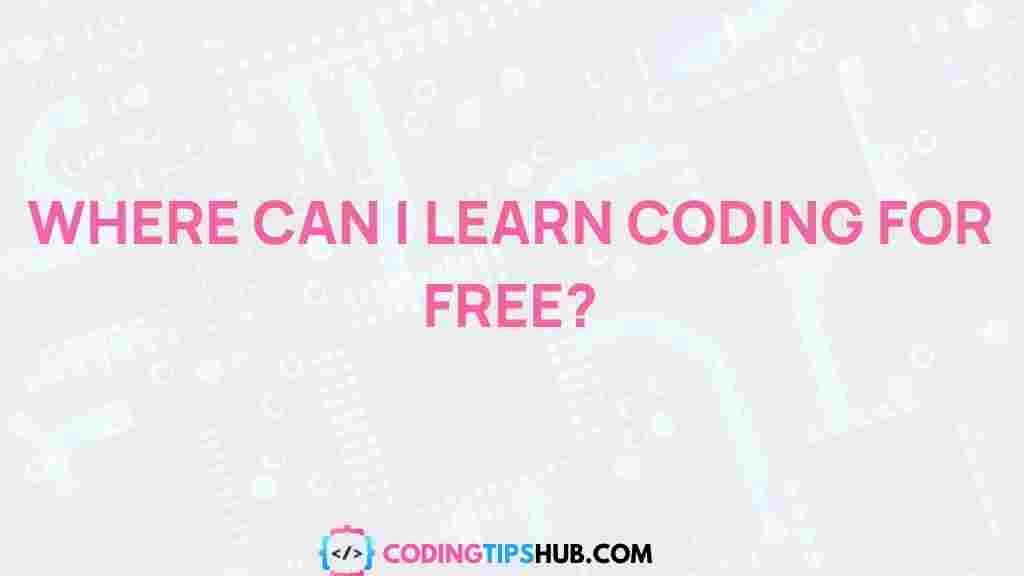Unraveling the Mystery of Free Coding Education
In today’s rapidly evolving digital landscape, the demand for coding skills is higher than ever. Whether you’re aiming to launch a new career or expand your technical abilities, free coding resources have made learning programming accessible to millions around the world. This article dives deep into the world of free coding education, offering insights into how to get started, the best resources available, and how to overcome common challenges.
What is Free Coding Education?
Free coding education refers to the wide variety of online resources, tools, and platforms that allow individuals to learn how to code without the burden of tuition fees. Unlike traditional educational methods, these resources often cater to learners of all skill levels and provide flexible learning opportunities.
Whether you’re a complete beginner or someone looking to refine your skills, the concept of free coding has revolutionized the way people approach learning to code. These resources can help you develop skills in languages such as Python, JavaScript, HTML/CSS, and more—without paying a dime.
Benefits of Learning to Code for Free
- Accessibility: With the internet’s reach, coding education can be accessed from anywhere in the world, allowing learners from all walks of life to participate.
- Affordability: Many people can’t afford the high cost of traditional coding bootcamps or university degrees. Free coding platforms level the playing field for everyone.
- Flexibility: Most free coding programs are self-paced, allowing learners to study whenever and wherever they choose, making it easier to balance with work or other responsibilities.
- Diverse Resources: From video tutorials and interactive lessons to coding challenges and forums, free coding education comes in many formats, catering to different learning styles.
How to Get Started with Free Coding
Now that you understand the importance and benefits of free coding, it’s time to embark on your learning journey. Here’s a step-by-step guide to help you get started:
Step 1: Choose a Coding Language
There are many programming languages available, and choosing the right one depends on your goals. If you are just starting out, here are a few popular languages you might consider:
- Python: Great for beginners due to its simple syntax and versatile applications in fields like web development, data science, and automation.
- JavaScript: Essential for web development. JavaScript allows you to build interactive websites and works on both the front-end and back-end.
- HTML/CSS: These languages are the backbone of web design. HTML structures web content, while CSS is used for styling.
- Java: Known for its reliability, Java is often used for building large-scale applications and Android development.
When starting, it’s best to choose one language and stick with it until you’re comfortable before moving on to others. Resources for beginners often provide detailed guidance on the best languages to learn based on your interests and goals.
Step 2: Select a Free Coding Platform
There are a wide variety of platforms where you can start learning for free. Here are some of the best options available:
- Codecademy: Offers interactive coding lessons in a variety of languages such as Python, JavaScript, and HTML/CSS.
- freeCodeCamp: A comprehensive, open-source platform offering free coding courses in web development, data science, and more. It also provides coding challenges and projects to help reinforce your learning.
- Khan Academy: Provides video tutorials and exercises for beginners in areas like JavaScript and HTML/CSS, making learning to code fun and engaging.
- Coursera and edX: While many courses here require payment for certification, you can audit most courses for free, offering access to high-quality university-level content.
- GitHub: A valuable resource for developers of all levels, GitHub offers community projects, tutorials, and open-source code you can learn from and contribute to.
Each platform has its own unique style of teaching, so try out a few to see which resonates best with your learning style.
Step 3: Set Clear Goals and a Learning Schedule
Learning to code can be overwhelming if you don’t have a structured plan in place. Setting clear goals is essential to keep yourself on track. Start by determining what you want to achieve. For instance, do you want to:
- Build a website?
- Create a mobile app?
- Enter the world of data science?
Once you have a goal, break it down into smaller, manageable tasks. Schedule regular study times and stick to them. Consistency is key in mastering coding, especially when learning on
This article is in the category Guides & Tutorials and created by CodingTips Team
